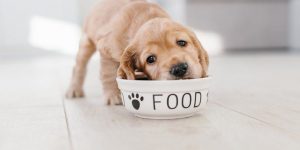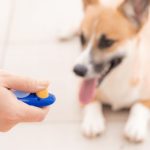Food Guarding in Dogs.
Food guarding, (or resource guarding), is one of the more common problems that can occur with family dogs. Fortunately, in most cases, it is relatively easy to address. This Holidays4Dogs article will provide some hints and tips on how to ensure your dog is happy eating his food around other people or dogs.
Food guarding is just one aspect of guarding behaviour in dogs. The dog may feel the need to defend food, toys, resting places or, in some cases – people. Food is one of the more common resources that dogs may attempt to defend. Many people might advocate leaving a dog in peace while they eat their dinner. While this is true, in part, you also need to make sure that your dog is not liable to snap, or even bite unexpectedly – especially if there are children in the house.
You can prevent food guarding developing in the first place, by using safe techniques when training your puppy. This way he, or she, will be happy to have people around them while enjoying their meal. With older dogs, the principle is the same.
However, if you are unsure, or worried about your dog biting you because the reactions are severe, it is essential you enlist the help of good dog trainer, or behaviourist. Never attempt to rectify this problem yourself if you do not feel safe around your dog, or confident in how to manage these techniques.
Tip 1.
 When it’s dinner time – prepare your dog’s food but only place a very small bite sized amount in his dinner bowl. Your pup’s reaction will probably be one of disbelief there is so little food in the bowl!
When it’s dinner time – prepare your dog’s food but only place a very small bite sized amount in his dinner bowl. Your pup’s reaction will probably be one of disbelief there is so little food in the bowl!
The process of eating lasts so briefly there will be little time for the puppy to become possessive. It is very likely the dog will then look up at you as if to say, “was that it?!”
Wait a few moments, perhaps busy yourself with another task. Pick up the food bowl and place another small morsel into it. Ask your dog to sit, then give them the next course. Proceed in this way until the helping for that meal has all gone.
This process helps to teach the dog to have a positive association between their food bowl – and you. They will welcome the handling of the bowl as you pick it up and put it down again.
Tip 2.
While your pup is eating dinner, casually walk over and drop something really tasty on top, such as grated cheese, or cooked liver. Once your dog realises the approach of feet, means more treats will appear in the food bowl, they will be much less inclined to react to movement around the bowl.
When your pup gets the hang of this, ask other family members to do the same. As they get used to the procedure – place tasty treats in the bowl, rather than drop them in. Your dog will quickly learn that an approach by a person, is a good thing. Therefore, they will be much happier to accept people near the food bowl.
Tip 3.
Place your dog’s food bowl on the floor with nothing in it. The dog may well be quite astounded and may even beg for you to put something in it. At this point, drop a small amount of food in the bowl. Wait for the dog to look up at you in anticipation. As they do so, place another morsel of food in the dish. Just like the other techniques, it is important to remain cool, calm and collected.
The process should be carried out gradually over a period of weeks. If you notice your dog is stiffening, growling, snarling, lip curling or, eating their meal at a greater speed as you approach, it would be advisable to get expert help from a trainer, or behaviourist. It is important that you safely address the behaviour.
Tip 4.
Teach your dog the, ‘take it – leave it’ cue – see our other Holidays4Dogs article ‘Teaching your Dog to Leave it‘ for more in-depth information on how to do this. Quite often, food aggression is not an isolated behaviour. It may be associated with other aggressive-type behaviours, so it should be addressed early on.
If your dog is being possessive towards other dogs in the household, ( or other pets such as cats, for instance) it is recommended each dog (pet) is fed separately. Indeed, this is a practice that should be considered in multi-dog households. Depending on the temperament of each dog, feeding in close proximity can sometimes instigate possessive / aggressive behaviour, so it is best not to allow this to occur in the first place.
Final thoughts.
Don’t wait until a food guarding problem becomes so bad, that you are not confident in dealing with it, or your dog has resorted to snapping – or even biting someone.
Always use positive training techniques and never antagonise your dog, or put your self in the position of being injured.
Never, use lead jerk training, or other such methods. Walk away from any trainer who suggests this approach, as this will almost certainly make the food aggression worse. It can also create other negative behaviours.
With a little patience and the correct handling, resource guarding is a relatively simple problem to fix. Not only will you be happier and more relaxed over doggy meal times, your dog will be too.


